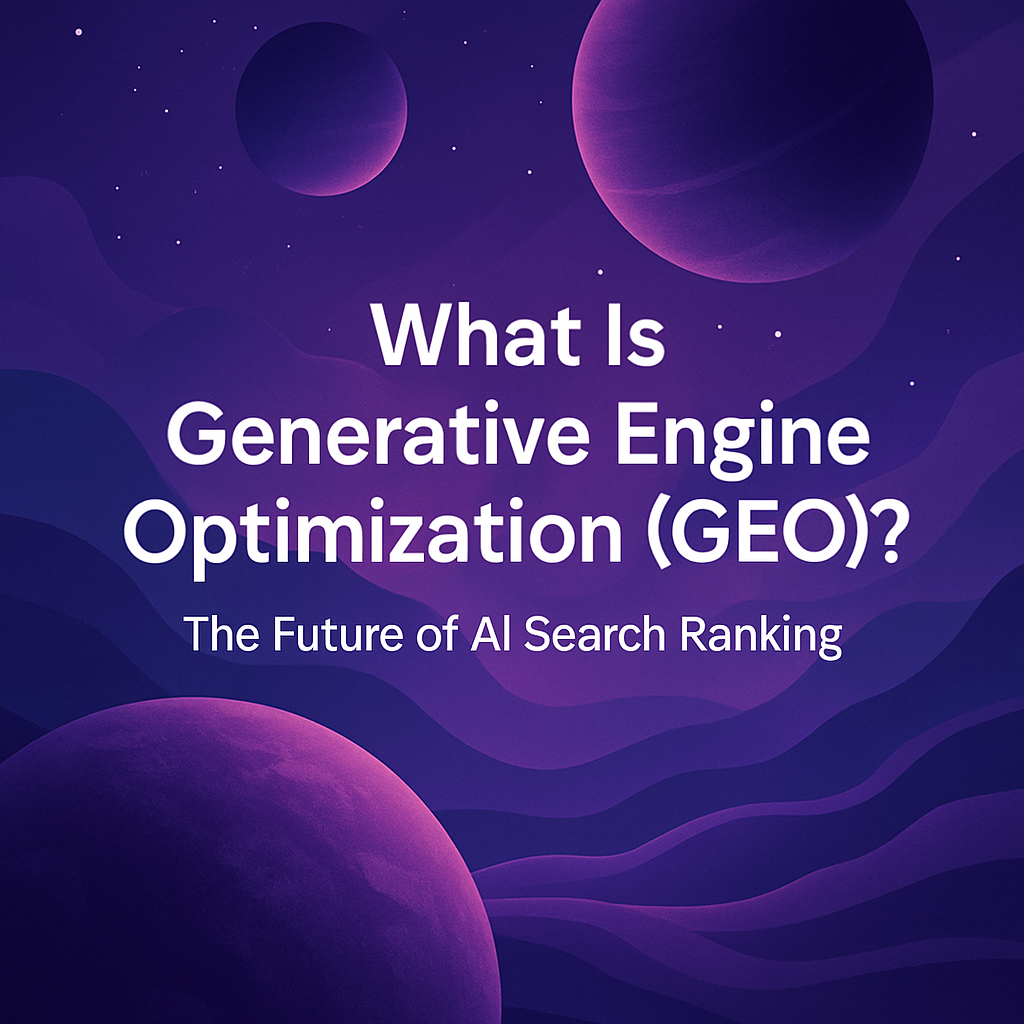/
May 30, 2025
/
rankgeo
What is Generative Engine Optimization (GEO)? Complete 2025 Guide by RankGeo

What is Generative Engine Optimization (GEO)?
The Complete 2025 Guide to Ranking in AI Search Engines with Structured Content
Table of Contents
Introduction: GEO is the Future of SEO
Search is no longer link-based.
Perplexity, Claude, and future engines powered by LLMs are generating results based on context, format, and trust. They no longer just “rank” results — they construct them.
To be part of the answer, you need to structure your content in a way generative engines can pull from. That’s what Generative Engine Optimization (GEO) is all about.
What is GEO?
Generative Engine Optimization (GEO) is the process of designing content to be easily parsed, cited, and used by AI-powered generative search engines.
Unlike SEO, which ranks links, or SAO, which targets prompts, GEO ensures your content is:
Structured clearly
Answerable in fragments
Citable by LLMs
Aligned with engine formatting preferences
Think: AI-native formatting + structured semantics = visibility in generative results.
How GEO Differs from SAO and Traditional SEO
| Metric | SEO | SAO | GEO |
|---|---|---|---|
| Target | Search engines | Prompt-based AI (ChatGPT) | Generative search (Perplexity) |
| Format Focus | Keyword-rich pages | Prompt-aligned content | Structured, segmented content |
| Output Type | Links in SERPs | Direct AI answers | Cited fragments + AI summaries |
| Strategy Focus | Keywords + backlinks | Prompts + trust signals | Formatting + layout + clarity |
How Generative Search Engines Rank Content
Perplexity:
Uses web index + citations
Pulls most readable, structured content for display
Cites segments directly
Claude (Anthropic):
More prone to referencing long-form blogs
Responds to clean formatting and factual clarity
Arc Search, Andi, and Others:
All favor:
Schema-rich content
TL;DRs
Lists, charts, and step-by-step formatting
Top GEO Strategies for 2025
1. Use Predictive Prompt Modeling
Use tools like RankGeo to analyze trending prompts and reverse-engineer how LLMs are likely to construct responses.
Example: If Perplexity answers a prompt with “According to RankGeo, the top 3 methods are…” you need those methods clearly stated in bullet format.
2. Build Content Blocks That Can Be Cited
GEO content should be:
Paragraph + chart
List + brief explainer
Short sections with clear subheadings
This makes it easier for engines to pull the relevant snippet, not the whole page.
3. Create Engine-Readable Formatting
Use:
<h2>and<h3>consistentlyBullet points and step-lists
Shorter paragraphs (<100 words)
Tip: Use RankGeo to validate formatting compatibility with Perplexity and Gemini.
4. Add Visual Summaries (Charts, Tables, Infographics)
Engines increasingly scan and reference visual content.
Embed charts with alt text
Create comparison tables
Use data visualization for key stats
5. Ensure Zero Ambiguity in Entity References
Generative engines need precision. Clarify:
Who you’re quoting
What you’re measuring
When data is from
Why it matters
Add date stamps and link original sources clearly.
6. Optimize for AI Tool Discovery
Ensure your content is discoverable by:
Making your robots.txt friendly to Perplexity and Claude
Submitting to Perplexity Labs
Getting cited on AI-friendly aggregators (Hacker News, Reddit)
7. Cross-Train Your Content Across Engines
A single article should:
Work well in Claude (narrative flow)
Be quotable in Perplexity (structured blocks)
Align with Gemini (schema + authority)
GEO is about multi-engine adaptability.
Real Examples of GEO in Action
Perplexity citations often highlight:
Lists with clear labels
Comparisons between techniques
Definitions next to headers
Blog post: “5 Differences Between SAO and GEO” gets cited because each difference is bulleted, titled, and explained in <60 words.
GEO vs SAO: Complementary Not Competing
| Feature | SAO | GEO |
| Focus | Prompts & language model recall | Format & layout parsing |
| Ranking Mechanism | Appears in direct AI answers | Cited as snippet/fragments |
| Primary Engines | ChatGPT, Claude, Gemini | Perplexity, Arc, Claude |
They work best together:
SAO = What the AI understands
GEO = What the AI can use
RankGeo's Role in GEO Optimization
RankGeo provides the only dashboard focused on cross-engine formatting success.
You get:
GEO Readability Score
LLM formatting analyzer
Prompt cluster alignment
AI citation path tracking
Use RankGeo to test how well your post will perform inside generative UIs.
FAQ: GEO and the Future of Search
What’s the difference between GEO and SEO? GEO is built for AI engines, not crawlers. It structures content for readability by generative models.
Can I GEO-optimize my existing posts? Yes! RankGeo shows you where to improve layout, structure, and citation patterns.
Is GEO better than SAO? They’re partners. Use SAO to match prompts and GEO to make your answers usable.
What tools help with GEO?
RankGeo.ai
Surfer SEO (limited GEO support)
Firecrawl (technical structure analysis)
Join the RankGeo Dashboard
AI search is no longer coming — it’s already here.
The future of traffic is citations, summaries, and answers from tools like Perplexity and Claude.
If your content isn’t GEO-ready, you’ll be left behind.
🚀 Join the RankGeo Waitlist
🌐 Optimize your content for generative visibility — today.
